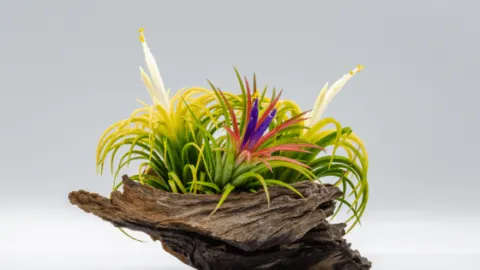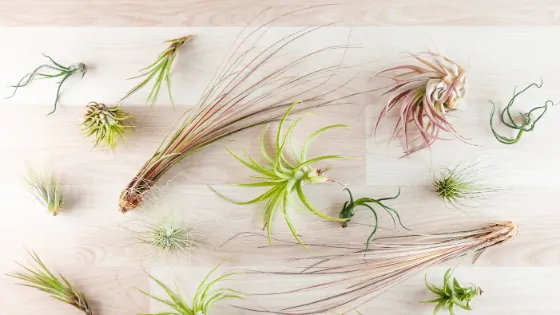
How to water (bigger) air plants – Soak them and let them dry upside down
In this article, we are going to tell you everything about how to water air plants. In a nutshell, what you need to do each time you water your air plant is to soak it and let it dry after soaking. For an air plant to dry properly, you need to put it upside down so the excess water can drain.
You may ask why this is necessary as air plants do not grow upside down mostly at least. Fair point. The answer is simple. You simply cannot compare outside conditions with indoor houseplant care. In their natural habitat air plants are exposed to wind and sunlight and will dry quickly.
Indoor air plants may stay wet for too long. This can lead to a rotting air plant. You want to make sure that there is no water remaining between the leaves.
This is why keeping your air plant upside down after watering for a couple of hours will help to get rid of all excess water. Shaking the remaining water off can also help.
You do not want to risk the crown of your air plant rotting. Once that happens your air plant is pretty much a goner. This is why how to water air plants the right way is so crucial.
Table of Contents
Let’s now go into more detail on how to water air plants with our in-depth step by step guide.
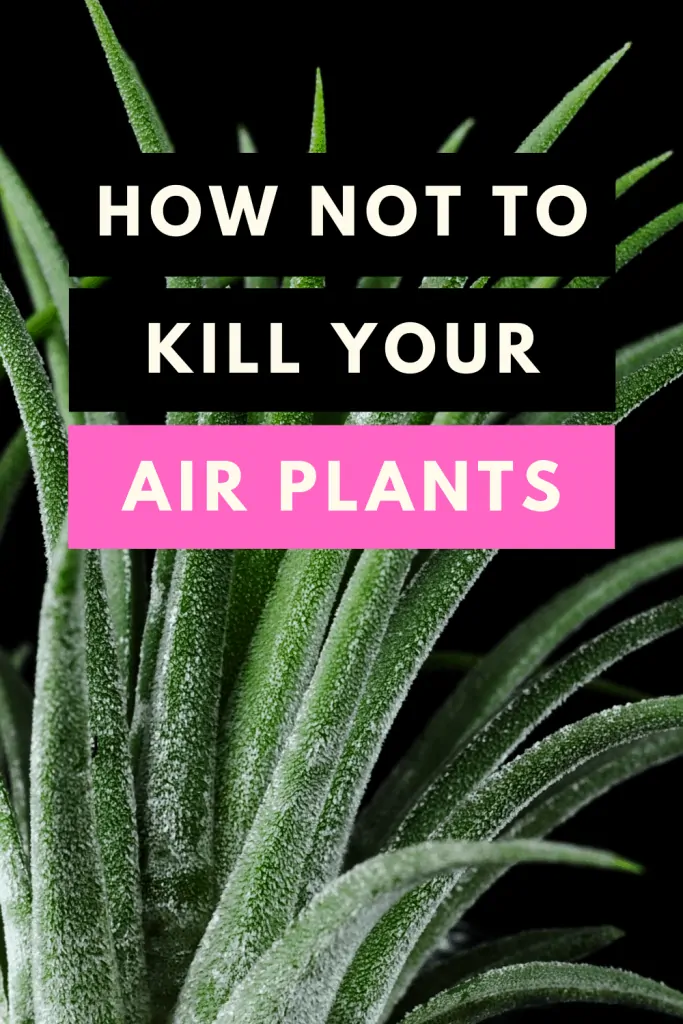
How NOT to kill your air plants – There are 3 different methods on how to water air plants.
How air plants intake water and nutrients
Air plants take nutrients and water in through their leaves and not through their roots. Many other plants mainly rely on their roots to intake sufficient water and the number of nutrients necessary to grow and flourish.
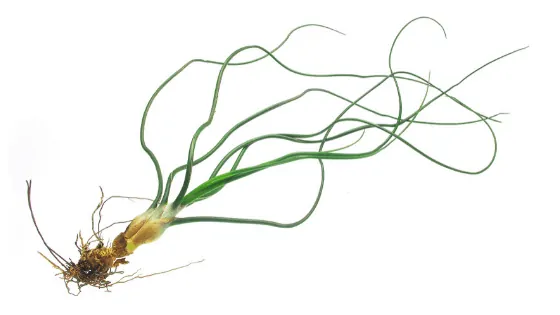
The roots of air plants are simply there to attach the plant onto other objects such as branches or rocks
The roots are there for the plants to attach to objects and other plants. There are simply there to fixate the air plants and do not play any role in how to water air plants.
Air plants have something called trichomes on their leaves. These are small little hairs that give many air plants this grey and fuzzy look. The leaves with its trichomes are there to absorb water and airborne nutrients.
They re also used by the air plants to regulate temperature.
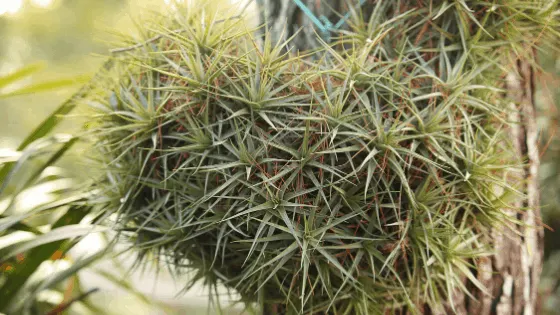
Tillandsia growing in its natural habitat
How to Water air plants Step by Step Guide
A big factor in how to water your air planta is light. The more light your plant gets, the more water it will need.
The same goes for temperature and humidity. The higher the temperature and the lower the humidity the more water your air plant needs.
How often do I need to water my air plants?
In very dry conditions water your air plants every 3-4 days. In humid conditions every 14 days is sufficient.
Step by step how to water air plants guide – Soaking method
Let’s now get into the step-by-step guide of how to water an air plant. These steps hold true for larger air plants:
As with all houseplants, water/soak your air plants in the mornings so they have sufficient time to respire.
- Soak your air plant weekly in room temperature water in the summer. Place it in a bowl of water and let it sit for 30mins
- Shake the excess water off and put the air plant upside down for 30min by putting it onto a towel. This step is key. If water remains trapped between the leaves your air plant will rot.
- Put your air plant back into its general spot and make sure it is completely dry within 4 hours.
- Good air circulation is crucial for a happy Tillandsia (air plant).
In winter you can reduce the soaking to every second week. Whilst bigger air plants are best soaked in water, smaller air plants can be misted instead.
So if you want to water a smaller air plant you could mist it once a week instead of soaking. When misting, make sure that you are misting your air plant thoroughly but ensure that no water is flowing down into the crown of your Tillandsia.
This is how to water air plants whether they re big or small. Let’s now move to the next section and talk about the signs you can spot to tell if your air plants need water.
How to water air plants – Misting
If you are misting your air plants you will have to mist them every other day. This holds especially true for households where low humidity reigns.
Rinsing your air plants
The third method of how to water air plants is to rinse them. If you decide to rinse your air plants do it twice a week. Put them under a faucet with running water and rinse them thoroughly.
After that put them on a paper towel and let them dry. If you are using a glass terrarium or enclosure to keep your air plants wait at least 3-4 hours before putting them back. Good airflow is crucial.
Where to water your air plants?
You can water air plants by using a bathtub or sink. Fill in water and make sure it has room temperature. Make sure that there is sufficient water present so your air plant can float.
If you have a family and live in a place with multiple people it might be easier to just pick a bowl and fill it with water. This is perfectly fine too. You can let your air plants sit in a bowl with water for 30 min in order to provide your plant with sufficient water.
How do I know if my air plant needs water?
The above-given suggestion is great and generally applicable. However, the best plant care can be provided if you are able to read and know what your air plants need.
But how do I know what my air plant needs? In air plants, a great telltale is the leaves as with most other plants. Based on how the leaves look like you can tell if an air plant needs water.
If an air plant gets a little dry, the leaves will start to curl inwards. This is a good sign that your air plant needs watering or misting. Depending on how hot and dry it is and how the air humidity is, this can happen before 7 days have passed since the last misting or watering.
Signs that your air plant needs water
Leaf tips turning brown and crisp
If leaf tips are browning and/or crisp it can be a clear sign that your air plant is underwatered. A different reason might be that it receives too much sun or artificial light. If both of these can be ruled out your air plant is most likely underwatered.
However, if you have just gotten your air plant via mail a little browning can be normal. The plants get stressed in the process and had to endure less than optimal conditions.
Wrinkled and rolled leaves
When your air plant needs water it might show that with rolled up and wrinkled leaves. As the water gets scarce, the plant will decide that it needs the humidity at the base of the plant and will slowly start to give up leaves.
How to water air plants? If you spot any of these signs you know that the time is right to water your air plants. Proceed with your regular care and let your air plant soak this time a bit longer. If you do soakings of 30min usually you can soak your air plants for 2-3 hours as they were underwatered.
After that return to your usual schedule.
Signs that your air plant is overwatered
Leaves falling off
Leaves falling off from your air plant in conjunction with browning and turning black are a sign of overwatering. Once this stage is reached there is little hope that you will be able to save your air plant.
How to water air plants is as much about learning from your mistakes and adjusting your care. I had one air plant where I possibly overdid it a bit with misting at one point.
When I tried to lift it up one day it literally crumbled in my hand and I was holding mere pieces of what was once a good looking air plant.
The best thing you can do is to try to do better next time. Let your air plants dry out and make sure that you are not staying too wet for too long. After the rotting process has started it is only downhill from there.
The best location for your air plant
The right location is crucial for how to water air plants. The drier it is the more water your air plants need. The more humid it is the fewer waterings are needed. In general, the best spot is a spot with bright light and good air circulation.
If the spot you are keeping your air plant in is very humid you can reduce watering
The biggest difference between air plants and most other houseplants is that they are epiphytic according to the PennState University. Being an epiphyte means that Tillandsia is plants that grow on other plants and various surfaces but not in soil.
They produce roots as other plants do but these are not meant to grow into the soil or to soak up water. They are simply there to help air plants to hold onto the surface they are growing on.
Frequently asked questions about watering air plants
How to water air plants?
There are multiple ways to provide your air plans with water and nutrients. In nature, air plants intake water through the air. Air plants have trichomes on their leaves. These are small hairs that help air plants to intake water. When watering your air plants indoors you can either soak, rinse or mist them.
How often to water an air plant?
Water your air plant once every seven days. Depending on the location your air plant is at, you might need to water more or less. In very dry conditions you might have to water your air plant every 3-4 days. In very humid condition once every 14 days is sufficient.
Is my air plant dead?
Air plants are very different to other plants that are not part of the Tillandsia genus. They got their name because they intake most of their nutrients through the air and through the rainfall. They certainly look very dry but as long as your air plant is not crumbling and the leaves are not falling off it is not dead.
Why are leaves falling off my air plant?
When leaves start to fall off it is an indicator that your air plant is rotting and deteriorating. At this stage, it is almost impossible to save your air plant. Make sure that you dry the air plant completely by putting it upside down and put it in a bright spot where the air circulation is good.
Why does my air plant have brown and black spots?
Brown and black spots are an indicator that your air plant has been too humid. Change the location to a bright spot with good air ventilation and make sure that your air plant can dry off after watering.
Do I need to put my air plant into soil?
Air plants are epiphytes. This means that they are living on other objects and plants. They do no need soil to get nutrients and to intake water. Their roots are simply present to help them attach to objects. They do and should not be put into the soil.
How to revive an air plant?
Once your air plant has rotted, it is dead. When it crumbled and all the leaves are falling off there is no way to bring it back.
How can I save an overwatered air plant?
The answer is it depends on the condition of your air plant. If it crumbles in your hands and the leaves are already falling off it will be most likely too late. If your Tillandsia is very wet and has some brown and black spots it might be still salvageable. Put it upside down on a towel to dry out. Once the plant is dry turn it around again. Make sure to provide sufficient airflow.
How to save an underwatered air plant?
An underwater air plant can be saved. Water your air plant by soaking it for 30min. Make sure to shake off as much water as possible afterwards and put it upside down on a towel to dry out. Do not overdo the watering and stick to your schedule even if the air plant looks very dry and underwatered.
What water is best for an air plant?
The best water you can provide your air plant is collected rainwater. However, you can also water using regular tap water.
How often do I need to water an air plant?
Once a week (every seven days) is a good rule of thumb. However, this is a general suggestion and the drier your home is the more you need to water your air plant. The more humid your conditions are the fewer watering is needed.
Do air plants need water?
Air plants need to be watered. There are two different methods to provide water for your Tillandsia. Either water your air plant by soaking it once a week or by spraying it with water.
Do air plants live from the air?
Although air plants are called air plants, they need nutrient to survive as does any other living organism. They do get most of their nutrients from the air as well as from the water in the form of rainfall.

Daniel has been a plant enthusiast for over 20 years. He owns hundreds of houseplants and prepares for the chili growing seasons yearly with great anticipation. His favorite plants are plant species in the Araceae family, such as Monstera, Philodendron, and Anthurium. He also loves gardening and is growing hot peppers, tomatoes, and many more vegetables.

